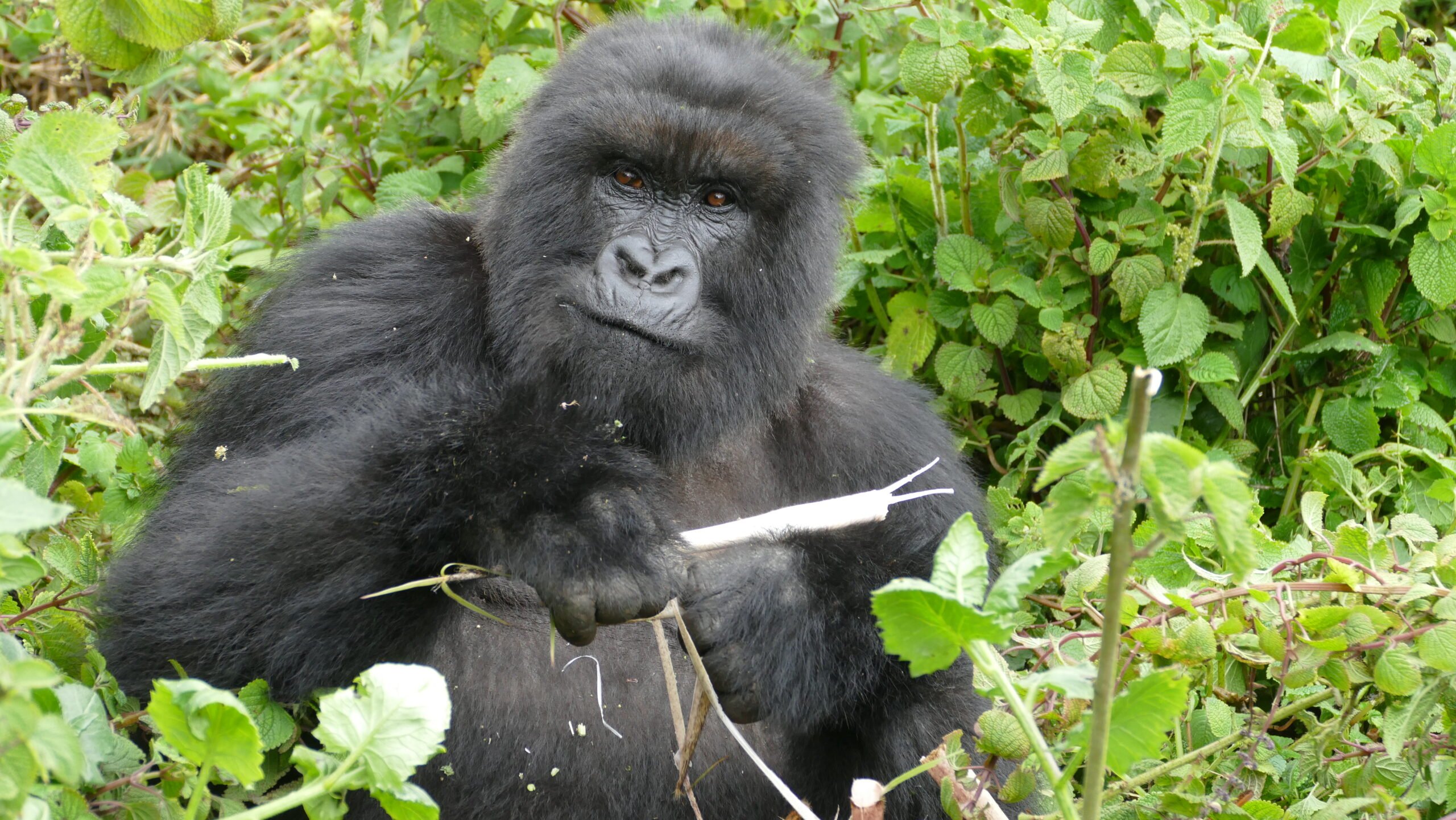
Yes, Fossey Fund field staff spend a lot of time collecting and analyzing gorilla fecal samples, and while this may seem an unpleasant task, it turns out that these samples provide a tremendous amount of information about each individual gorilla. Often, this is information we wouldn’t otherwise be able to detect and that may be quite important.
Our Rwanda Research Manager, Dr. Winnie Eckardt, has conducted many studies using gorilla fecal samples as a prime source of data, and says: “Observing with our eyes does not provide as much information as we’d like, and we can’t take samples of anything that would be invasive (like blood samples), so collecting fecal samples has become our method of choice for accessing biomarkers and other information useful for understanding the gorillas and their conservation needs.”
Here are some of the things we can learn from gorilla poop samples, and why:
- Paternity: Since there are groups with more than one silverback (potential fathers) we can’t always be sure who sires whom. But when feces pass through the intestinal tract, they pull some body cells with them, containing the full genome of the individual! Then we can compare and know for sure who the fathers are.
- Stress: Gorillas in the wild face various stressors, ranging from snares to inter-group encounters to climate change, and fecal samples allow us to non-invasively measure certain substances that show up as a result of stress, including chronic stress. Sometimes knowing the extent of this issue may help us find conservation strategies to mitigate the effects.

- Health status: Examining feces for the presence and amount of parasites, as well as for the overall gut microbiome, is one way to look for indicators of health and can help us identify illnesses.
- Dietary information: Feces also show us what a gorilla consumed, as we look for microscopic particles from food plants in the samples. This is important for their conservation, since plant availability is also subject to various threats.
- Mother’s milk: We’re able to study isotopes found in feces that help us determine when a nursing mother has ended milk production. This is important because then we know which mothers are ready to reproduce again. Sometimes youngsters suckle even when milk production has ended or when we’re not in the field, so this is a better way to know what is happening and what to expect next.

- Individual identity: Approximately every five years, a complete census of the mountain gorillas in the Virungas is conducted, and these surveys are heavily dependent on counting night nests. Each gorilla generally makes one nest each night but sometimes can build two or more. By taking samples of feces from each nest, we can use DNA analysis to make sure we are not undercounting or overcounting the true number of individual gorillas in the forest. We can also use the DNA to locate gorillas that have moved out of our tracking range and into other areas of the mountains.
- Science: We have done many studies and have many underway – on multiple topics – that are dependent on fecal samples. These include investigations of stress physiology, female hormonal cycles, the relationship between infant mortality and paternity, causes of illnesses, and how gorillas avoid inbreeding.
How we collect and analyze samples
Our field staff have found that a good time to collect fecal samples is when gorillas stand up after one of their resting periods during the day, which usually occur after they have eaten a lot and are digesting their food. But we are also practicing other methods, such as following the gorillas we are focusing on and waiting for them to defecate. In either case, the collection is done after the gorilla has moved away, so as not to disturb their behaviors.
Fecal samples are collected by picking them up with gloved hands, then folding a glove carefully over the feces to utilize the glove as a transport bag to our lab at the Karisoke Resarch Center. A piece of paper with the collection date and time as well as the gorilla’s identity is attached to each sample.

Since the goal is to capture fresh samples, it’s also important to orchestrate not only the collection of samples but their transference to our lab quickly, or to get a request for a specific sample from the lab to the field staff. We now actually have a “gorilla poop group” on WhatsApp to more efficiently inform our teams in the field about what fecal samples are needed in the lab and to alert the lab team when fecal samples are arriving from the field!
And then there’s analysis of these samples, which varies depending on what we are looking for. Hormone extraction, for example, is a specialized procedure and we have a lab coordinator – Rose Umuhoza – who is a champion in this regard, having extracted hormones from thousands of samples since 2011. These hormones are then shipped to a partner lab at the Lincoln Park Zoo. Some microscopic analyses are done at our lab, as well as preservation and storage for samples that will be analyzed later at outside labs.
Of course there’s much more to say about gorilla fecal samples and the critical role they have played in our studies of this endangered species. To see a full list of scientific studies about the mountain gorillas, click here. Dr. Eckardt’s study on stress physiology and a study by Dr. Stacy Rosenbaum showing that male rank rather than paternity predicts male-infant relationships, are examples of studies that were heavily dependent on findings from fecal sample analysis.






